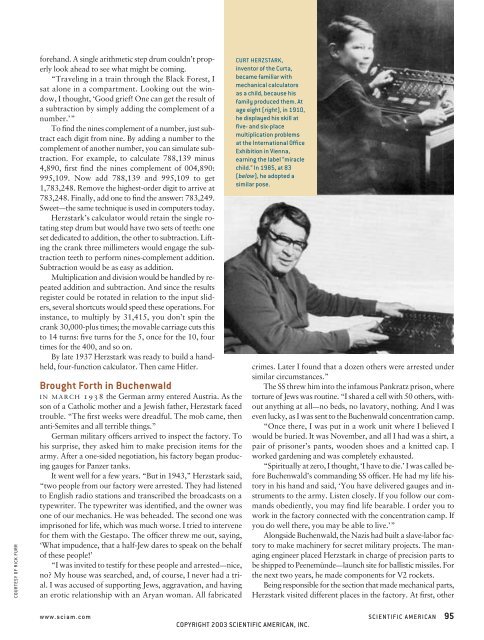Scientific American
Scientific American
Scientific American
Create successful ePaper yourself
Turn your PDF publications into a flip-book with our unique Google optimized e-Paper software.
COURTESY OF RICK FURR<br />
forehand. A single arithmetic step drum couldn’t properly<br />
look ahead to see what might be coming.<br />
“Traveling in a train through the Black Forest, I<br />
sat alone in a compartment. Looking out the window,<br />
I thought, ‘Good grief! One can get the result of<br />
a subtraction by simply adding the complement of a<br />
number.’”<br />
To find the nines complement of a number, just subtract<br />
each digit from nine. By adding a number to the<br />
complement of another number, you can simulate subtraction.<br />
For example, to calculate 788,139 minus<br />
4,890, first find the nines complement of 004,890:<br />
995,109. Now add 788,139 and 995,109 to get<br />
1,783,248. Remove the highest-order digit to arrive at<br />
783,248. Finally, add one to find the answer: 783,249.<br />
Sweet—the same technique is used in computers today.<br />
Herzstark’s calculator would retain the single rotating<br />
step drum but would have two sets of teeth: one<br />
set dedicated to addition, the other to subtraction. Lifting<br />
the crank three millimeters would engage the subtraction<br />
teeth to perform nines-complement addition.<br />
Subtraction would be as easy as addition.<br />
Multiplication and division would be handled by repeated<br />
addition and subtraction. And since the results<br />
register could be rotated in relation to the input sliders,<br />
several shortcuts would speed these operations. For<br />
instance, to multiply by 31,415, you don’t spin the<br />
crank 30,000-plus times; the movable carriage cuts this<br />
to 14 turns: five turns for the 5, once for the 10, four<br />
times for the 400, and so on.<br />
By late 1937 Herzstark was ready to build a handheld,<br />
four-function calculator. Then came Hitler.<br />
Brought Forth in Buchenwald<br />
IN MARCH 1938 the German army entered Austria. As the<br />
son of a Catholic mother and a Jewish father, Herzstark faced<br />
trouble. “The first weeks were dreadful. The mob came, then<br />
anti-Semites and all terrible things.”<br />
German military officers arrived to inspect the factory. To<br />
his surprise, they asked him to make precision items for the<br />
army. After a one-sided negotiation, his factory began producing<br />
gauges for Panzer tanks.<br />
It went well for a few years. “But in 1943,” Herzstark said,<br />
“two people from our factory were arrested. They had listened<br />
to English radio stations and transcribed the broadcasts on a<br />
typewriter. The typewriter was identified, and the owner was<br />
one of our mechanics. He was beheaded. The second one was<br />
imprisoned for life, which was much worse. I tried to intervene<br />
for them with the Gestapo. The officer threw me out, saying,<br />
‘What impudence, that a half-Jew dares to speak on the behalf<br />
of these people!’<br />
“I was invited to testify for these people and arrested—nice,<br />
no? My house was searched, and, of course, I never had a trial.<br />
I was accused of supporting Jews, aggravation, and having<br />
an erotic relationship with an Aryan woman. All fabricated<br />
CURT HERZSTARK,<br />
inventor of the Curta,<br />
became familiar with<br />
mechanical calculators<br />
as a child, because his<br />
family produced them. At<br />
age eight (right), in 1910,<br />
he displayed his skill at<br />
five- and six-place<br />
multiplication problems<br />
at the International Office<br />
Exhibition in Vienna,<br />
earning the label “miracle<br />
child.” In 1985, at 83<br />
(below), he adopted a<br />
similar pose.<br />
crimes. Later I found that a dozen others were arrested under<br />
similar circumstances.”<br />
The SS threw him into the infamous Pankratz prison, where<br />
torture of Jews was routine. “I shared a cell with 50 others, without<br />
anything at all—no beds, no lavatory, nothing. And I was<br />
even lucky, as I was sent to the Buchenwald concentration camp.<br />
“Once there, I was put in a work unit where I believed I<br />
would be buried. It was November, and all I had was a shirt, a<br />
pair of prisoner’s pants, wooden shoes and a knitted cap. I<br />
worked gardening and was completely exhausted.<br />
“Spiritually at zero, I thought, ‘I have to die.’ I was called before<br />
Buchenwald’s commanding SS officer. He had my life history<br />
in his hand and said, ‘You have delivered gauges and instruments<br />
to the army. Listen closely. If you follow our commands<br />
obediently, you may find life bearable. I order you to<br />
work in the factory connected with the concentration camp. If<br />
you do well there, you may be able to live.’”<br />
Alongside Buchenwald, the Nazis had built a slave-labor factory<br />
to make machinery for secret military projects. The managing<br />
engineer placed Herzstark in charge of precision parts to<br />
be shipped to Peenemünde—launch site for ballistic missiles. For<br />
the next two years, he made components for V2 rockets.<br />
Being responsible for the section that made mechanical parts,<br />
Herzstark visited different places in the factory. At first, other<br />
www.sciam.com SCIENTIFIC AMERICAN 95<br />
COPYRIGHT 2003 SCIENTIFIC AMERICAN, INC.

















